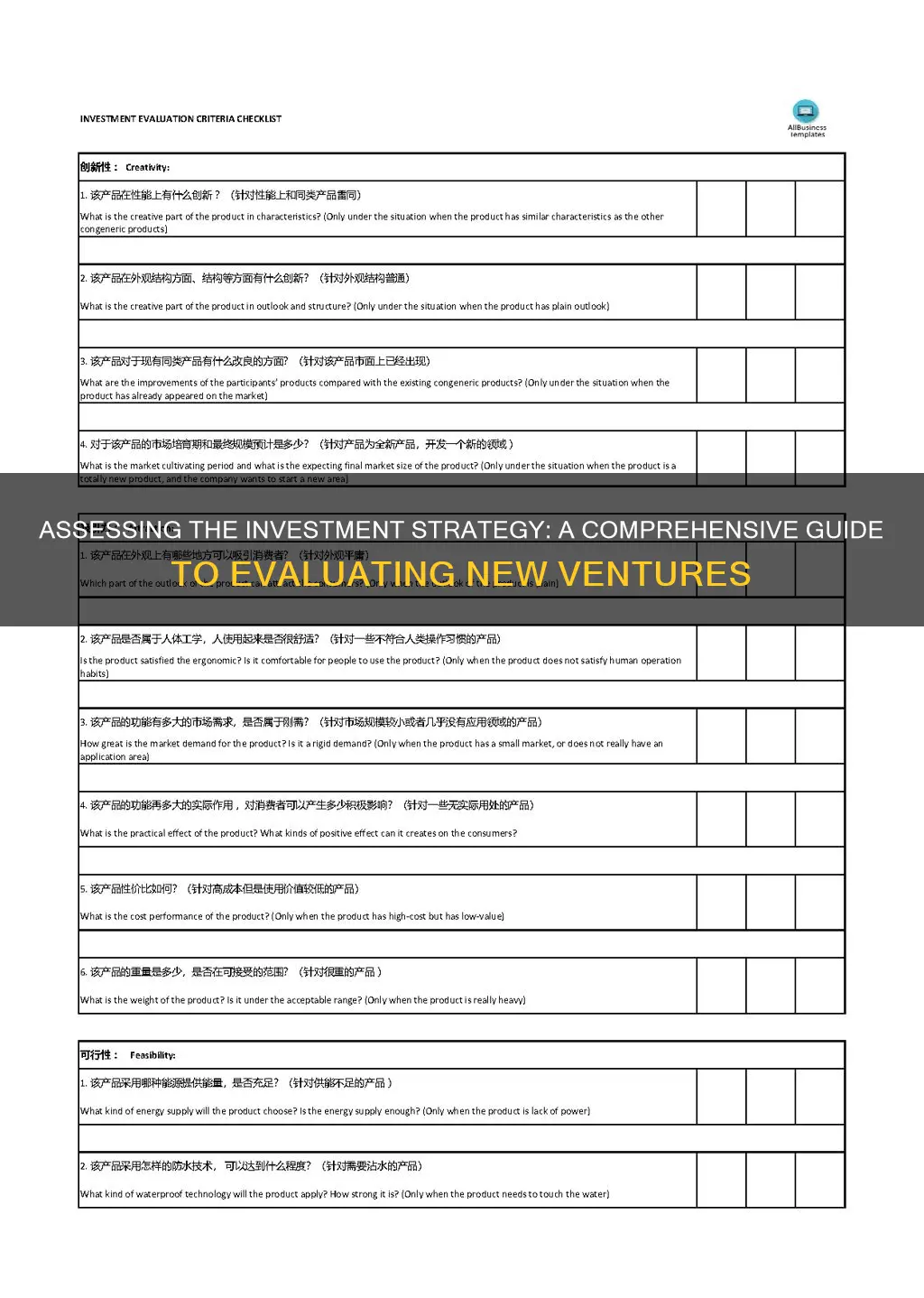
Evaluating a new investment plan is a critical step in ensuring the success of your business and achieving your strategic goals. It involves a thorough assessment of various factors to determine if the investment aligns with your business needs and overall strategy. Here are some key considerations when evaluating a new investment plan:
- Strategic fit and timing: Ensure that the investment aligns with your company's needs and overall strategy for the next several years. Consider the current outlook, potential disruptions, and whether the investment will detract attention and resources from your core business.
- Cost-benefit analysis: Perform a cost-benefit analysis to evaluate the financial viability of the investment. Consider methods such as payback period, accounting rate of return, net present value, and internal rate of return. Be realistic in your estimates for costs and revenues.
- Impact on cash flow: Assess the impact of the investment on your cash flow. Ensure that your operations can generate enough cash flow to absorb the increase in outflows. Include all expected outflows, such as acquisition costs, lease payments, and interest on additional financing.
- Financing requirements: Determine the financing needs based on the projected cash flow impacts. Approach bankers with a solid case for the investment and provide up-to-date financial information about your company.
- Alternative options: Weigh the investment against alternative options, such as improving existing assets or doing nothing. Evaluate the competitive edge the investment will bring and the risks associated with not making the investment.
- Operational impacts: Consider the potential impacts on various aspects of your business, including sales, procurement, production, and delivery capabilities. Assess the implications on your workforce and whether there will be challenges in finding qualified employees or attaining required efficiency.
- Total cost of ownership: Evaluate the total cost of purchasing and operating the investment, including maintenance and financing costs. Compare the investment cost with alternative options to ensure you are getting the best value.
- Return on investment: Estimate the expected return on investment, considering factors such as resale price, income generated, and savings. Calculate the net amount by subtracting the money going out from the money coming in. Compare this with other investment opportunities to determine if the investment is worth it.
| Characteristics | Values |
|---|---|
| Strategic fit | The investment should align with the company's needs and overall strategy for the next several years. |
| Timing | Consider the current outlook for your business and industry and any potential disruptions on the horizon. |
| Cost-benefit analysis | Use methods such as payback period, accounting rate of return, net present value, and internal rate of return to evaluate the investment opportunity. |
| Cash flow impact | Ensure the investment makes sense from a cash flow perspective and include all expected outflows in your projections. |
| Financing | Determine the financing needs and approach bankers with a solid case for the investment and your business plan. |
| Other impacts | Consider the implications on sales, procurement, production, delivery capabilities, and workforce. |
| Risk | Evaluate the level of risk and whether it is acceptable. Consider the probability of losing capital and the potential impact on your wealth plan. |
| Return time frame | Assess the desired time frame for income and growth investments, considering factors such as payment schedules and market cycles. |
| Cost | Evaluate the cost to buy and own the investment, including fees, commissions, and expense ratios. |
| Capital cost | Determine how much capital is required to achieve the desired results, such as income or growth. |
| Net worth | Assess how well the investment fits into your current investment portfolio and overall net worth. |
What You'll Learn

Is it a good strategic fit?
When evaluating a new investment plan, it is crucial to assess whether it aligns with the company's strategic goals and direction. This concept is known as "strategic fit," which refers to how well the investment complements the existing business activities and contributes to achieving competitive advantage and business success. Here are some factors to consider when determining if the new investment plan is a good strategic fit:
Resources and Capabilities:
The company should evaluate if it possesses the necessary resources and capabilities to execute the investment strategy successfully. Resources can be tangible, such as financial assets, physical assets like location and machinery, and technology patents or copyrights. Capabilities, on the other hand, refer to the company's knowledge and learning accumulation. It is essential to differentiate between these two, as they play different roles in the investment strategy.
External Environment and Opportunities:
The investment plan should consider the external environment, including market trends, customer needs, and competitor activities. By understanding the opportunities and challenges in the external environment, the company can assess if the investment plan aligns with its long-term strategic direction. This includes evaluating potential mergers and acquisitions (M&A) to ensure they fit with the company's planned strategy and offer better returns than organic growth.
Competitive Advantage:
The new investment plan should contribute to the company's competitive advantage. This could be through unique combinations of resources and capabilities that set the company apart from its competitors. By leveraging these strengths, the company can gain a competitive edge and enhance its market position.
Synergies and Cost Reductions:
The investment plan should be evaluated for its potential to create synergies within the organization. This could be through the efficient utilization of resources, improved coordination between different business units, or the achievement of economies of scale. Additionally, the plan should be assessed for its ability to reduce costs and improve operational efficiency.
Long-Term Strategic Direction:
The company should consider if the investment plan aligns with its long-term strategic goals. This includes assessing if the investment supports the company's overall strategy for the next several years and beyond. Short-term gains from an investment may not always be aligned with the company's long-term vision, so it is crucial to evaluate the investment's contribution to the company's future success.
In conclusion, when evaluating a new investment plan, it is essential to consider its strategic fit. By assessing the company's resources and capabilities, external environment, potential for competitive advantage, synergies, and cost reductions, as well as its alignment with the long-term strategic direction, the company can make informed decisions about the investment's suitability and potential contribution to its overall success.
Retirement Investment Strategies: Navigating Your Golden Years
You may want to see also

What are the impacts on cash flow?
When evaluating a new investment plan, it is crucial to consider its potential impacts on cash flow. Here are some detailed insights on how a new investment plan can affect cash flow:
Outflow and Inflow Dynamics:
The most direct impact of a new investment plan is on the cash flow dynamics of a business. Investing activities typically involve cash outflows, such as purchasing long-term assets, acquiring other businesses, or investing in marketable securities. These outflows can be significant and may require careful financial management to ensure liquidity. However, it's important to note that investing activities can also generate cash inflows through the sale of assets, divestitures, or proceeds from marketable securities.
Impact on Cash Position:
A new investment plan can significantly impact a company's cash position. Positive cash flow from investing activities indicates that the company is generating more cash from the sale or disposal of investments than it is spending on new investments. On the other hand, negative cash flow from investing activities means the company is investing more cash than it is receiving from investment-related activities. While negative cash flow doesn't always indicate a problem, especially if the investments are expected to generate positive returns in the long term, it is crucial to ensure that the business can sustain its operations and meet its financial obligations.
Alignment with Business Strategy:
The impact of a new investment plan on cash flow depends on its alignment with the business's overall strategy. If the investments are strategic and well-timed, they can drive growth and improve the company's financial position. For example, investing in new machinery or equipment can increase production capacity and efficiency, leading to higher revenue and improved cash flow. However, if the investments are not aligned with the business's needs or are poorly timed, they can detract resources and attention from the core business, potentially impacting cash flow negatively.
Financing Considerations:
The impact of a new investment plan on cash flow is closely tied to the financing options available. If a business has sufficient cash reserves or access to low-cost financing, it may be able to manage the cash outflows associated with the investment plan more easily. On the other hand, if a business relies heavily on debt financing, the interest and repayment obligations can affect cash flow. It is crucial to assess the financing requirements and ensure that the investment plan is financially viable without straining the business's cash position.
Risk and Uncertainty:
A new investment plan can introduce risks and uncertainties that impact cash flow. The expected returns on investments may not always materialize, and there is a chance of losses or lower-than-anticipated gains. Additionally, factors such as market fluctuations, changes in consumer demand, or unexpected disruptions can affect the performance of investments. These risks can influence cash flow, and it is important to consider them when evaluating the potential impact on cash flow.
In summary, evaluating the impacts of a new investment plan on cash flow involves analyzing both the immediate financial outlays and inflows, as well as the long-term strategic benefits and risks. By considering these factors, businesses can make informed decisions about their investment plans and ensure they have the necessary financial resources to support their operations and achieve their strategic goals.
Unlocking the Mystery: Using HELOC to Pay Off Your Mortgage
You may want to see also

What is the level of risk?
When evaluating a new investment, it is important to consider the level of risk involved. All investments carry some degree of risk, and this risk can be defined as the chance that an investment's actual gains will differ from the expected outcome or return. The level of risk can vary depending on several factors, and it is crucial to assess and understand these risks before making any investment decisions. Here are some key considerations regarding the level of risk:
Types of Risk
Firstly, it is important to distinguish between different types of risk. Systematic risk, also known as market risk, affects an entire economic market or a large portion of it. It includes factors such as political risk, macroeconomic risk, interest rate risk, inflation risk, currency risk, liquidity risk, country risk, and sociopolitical risk. These risks are challenging to mitigate through portfolio diversification. On the other hand, unsystematic risk is specific to a particular industry or company and can often be managed through diversification. Examples include changes in management, product recalls, regulatory changes, and the emergence of new competitors.
Risk Tolerance and Capacity
Before investing, it is crucial to assess your risk tolerance and capacity. Risk tolerance refers to your comfort level with taking on risk, while risk capacity is the amount of financial risk you can take based on your current financial situation. Factors such as age, income, investment goals, liquidity needs, and personality play a role in determining your risk tolerance and capacity. Younger investors with a longer time horizon might be more willing to take on higher-risk investments, whereas older investors might prefer more stable options.
Historical Performance and Volatility
Assessing historical behaviours and outcomes is a common method for quantifying risk. Standard deviation is often used to measure the volatility of asset prices compared to their historical averages, providing insight into the level of risk. Additionally, it is important to consider the volatility or price fluctuations of the investment. Higher volatility indicates greater risk and the possibility of significant losses if you need to sell prematurely.
Potential Losses
When evaluating risk, consider the possibility of losing some or all of your investment. Different investments carry varying levels of risk in terms of potential losses. For example, investments in stocks typically fluctuate but are unlikely to result in a complete loss of capital. On the other hand, investments in startups, real estate, or alternative investments carry a higher risk of complete loss.
Investment Horizon
The investment horizon refers to the amount of time you plan to hold the investment. If you have a short-term horizon and may need access to your funds in the near future, investing in high-risk options might not be advisable. Longer investment horizons provide more time to recoup potential losses and can make higher-risk investments more tolerable.
Diversification
Diversification is a crucial strategy for managing risk. By spreading your investments across various assets, industries, sectors, and regions, you can reduce the impact of specific risks associated with particular investments or sectors. A well-diversified portfolio can help balance risk and reward, providing a more stable foundation for your investments.
Due Diligence and Research
Conducting thorough due diligence and research is essential for understanding the level of risk associated with an investment. This includes analysing financial statements, assessing the company's management team, evaluating the competitive landscape, and considering economic and market factors. The more information you have, the better equipped you will be to make informed decisions about the level of risk.
In conclusion, evaluating the level of risk is a critical aspect of investment decision-making. By considering the different types of risk, your risk tolerance and capacity, historical performance, potential losses, investment horizon, diversification strategies, and conducting thorough due diligence, you can make more informed choices about the level of risk associated with a new investment.
Is Now the Time to Be All In?
You may want to see also

What is the expected rate of return?
The expected rate of return is a key consideration when evaluating a new investment plan. It is the projected profit or loss an investor can anticipate from an investment and is calculated by multiplying potential outcomes by the probability of them occurring and then totalling these results.
For example, if an investment has a 50% chance of gaining 20% and a 50% chance of losing 10%, the expected return would be 5% (0.5 x 0.2 + 0.5 x -0.1 = 0.05). This calculation is a useful tool for determining whether an investment is likely to have a positive or negative average net outcome.
When evaluating the expected rate of return for a new investment, it is important to consider both the potential returns and the likelihood of achieving those returns. This involves analysing historical data on the investment's past performance and using it to make forecasts about future returns. However, it is important to note that expected returns are not guaranteed and are subject to systematic and unsystematic risks.
Additionally, when evaluating a new investment plan, it is crucial to consider the investment's risk characteristics to ensure it aligns with your risk tolerance and investment goals. This includes assessing the standard deviation, which measures the investment's historical volatility or risk. By comparing the expected return with the risk-free rate of return, investors can make more informed decisions about whether the potential returns justify the level of risk.
Furthermore, the timing and strategic fit of the investment are also important factors to consider. Ensuring that the investment aligns with your company's needs and overall strategy, as well as assessing whether the current business and industry outlook are favourable, are essential aspects of the evaluation process.
In summary, determining the expected rate of return involves analysing historical data, calculating probabilities, and considering the investment's risk profile and strategic fit. By combining these factors, investors can make more informed decisions about whether to proceed with a new investment plan.
Germans' View on Chinese Investments
You may want to see also

What are the operating and maintenance costs?
When evaluating a new investment, it is crucial to consider the operating and maintenance costs, which can significantly impact the overall financial viability of the project. These costs can be broadly categorized into fixed and variable expenses, each with its unique characteristics and implications for the business.
Fixed operating and maintenance costs are those that remain relatively constant, regardless of the output or production level. Examples include rent for office or factory space, insurance, security, equipment, and salaries for essential employees. These costs provide the foundation for the business to function and are typically unavoidable. For instance, a manufacturing company must pay rent for its factory space, regardless of how much it produces or sells. While it can downsize to reduce rental expenses, it cannot eliminate this cost entirely. Fixed costs play a crucial role in achieving economies of scale. As production increases, fixed costs are spread out over a larger number of units, reducing the average per-unit cost and making production more efficient.
On the other hand, variable operating and maintenance costs fluctuate with changes in output or production levels. Raw material costs, electricity expenses, and sales and marketing costs are typical examples of variable costs. For instance, a fast-food chain selling french fries will need to increase its purchase of potatoes as it sells more fries. Variable costs have a direct correlation with production levels, and efficient management of these costs is essential to maintain profitability.
It is worth noting that some costs can be considered semi-variable or semi-fixed. These costs have both fixed and variable components, such as overtime labor. Regular wages are typically fixed, as a company will always need a workforce, but overtime payments vary with production levels and are influenced by labor productivity.
When evaluating a new investment, it is crucial to analyze both the fixed and variable operating and maintenance costs. This analysis should consider the short-term and long-term implications of these expenses on the business's financial health and productivity. It is important to strike a balance between cost-cutting measures and maintaining the ability to increase sales. Reducing operating costs too aggressively may hinder the company's productivity and, consequently, its profitability. Therefore, a comprehensive understanding of these costs is vital for making informed decisions about the new investment.
Understanding Your Retirement Investment Profile: A Guide to Navigating Your Golden Years
You may want to see also
Frequently asked questions
Consider whether the investment aligns with your company's needs and overall strategy for the next few years. Even if it is a good investment, it may not be the right investment for your business. Also, think about the current outlook for your business and industry and any potential disruptions on the horizon.
Conduct a cost-benefit analysis of the investment to ensure it is a good opportunity for your business. Various methods exist for doing this, including payback period, accounting rate of return, net present value, and internal rate of return. Be sure to make realistic assumptions and consider a range of scenarios when making your estimates.
Evaluate whether the investment makes sense from a cash flow perspective. Include all expected outflows in your cash flow projections, such as acquisition costs, lease payments, and interest on additional financing. Making an investment without considering cash flow could put you out of business.
Once you have projected the cash flow impacts, you can determine your financing needs and approach bankers about financing options. Bankers will want to see up-to-date financial information and a solid case for the investment and your overall business plan.
Think about the potential implications of the investment on various aspects of your business, such as sales, procurement, production, and delivery capabilities. For example, consider the impact on your workforce and whether there will be challenges with relocation or finding qualified employees in a new location.







